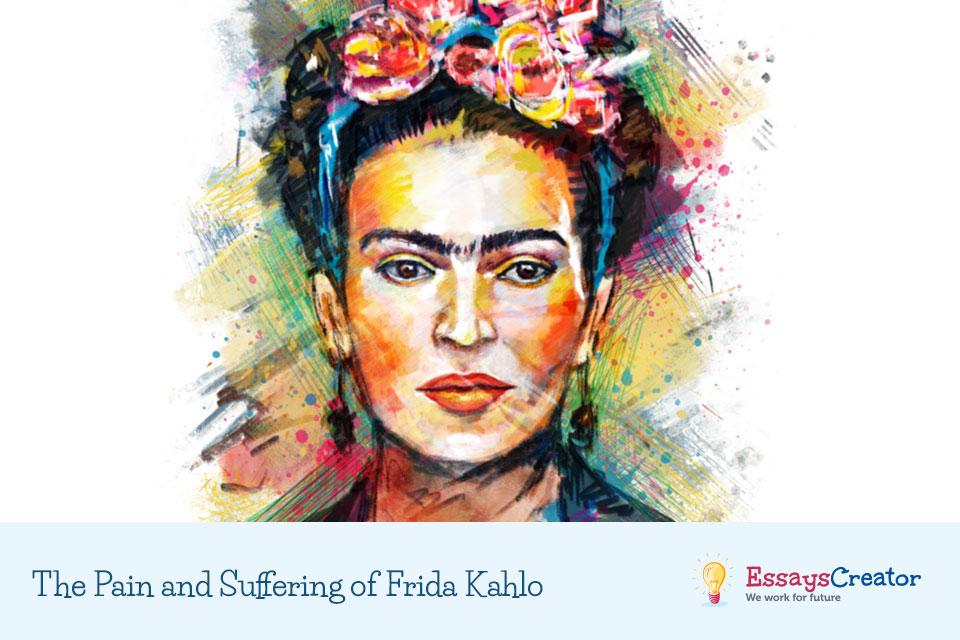
Introduction
Mexican artist Frida Kahlo, who appears in numerous unsmiling and sternly disturbing self-portraits, has recently acquired or maybe reacquired, a cult status. Germaine Greer called her a patron saint of both lipstick and lavender feminism, whereas in her lifetime surrealist king, Andre Breton, said she was like a ribbon wrapped about a bomb. One critic has written of Fridamania and in America, there have been recent exhibitions of other artists’ work on the theme of Homage to Frida. (Smith, 273) Many of us will have one or more images of her confrontational self-portraits in our private art galleries without walls that we carry around in our heads. Always unflinchingly staring directly at us from under the lintel of her graphic identikit-like eyebrows, she is often fringed with tropical plants and animals like some role-playing Catholic saint or, cocooned with complex references to her tragic life, again recalling religious votive images and, as much religious imagery, her art is painful to contemplate.
Thesis
In 1925, at the age of eighteen, Kahlo was involved in a serious bus accident in which a pole impaled her from stomach to pelvis. While recovering from the accident, Kahlo began to paint. The painting would become her salvation, providing an outlet for the tremendous physical suffering she would endure for the rest of her life. (Ankori, 22-58)
Analysis
Frida Kahlo, a twentieth-century artist, was born in Mexico to parents of mixed race. Her father was of Hungarian-Jewish descent and her mother was part Spanish and part Native American.
Order your History Essay help today!
Although Frida Kahlo was born in 1907, she claimed to be born in 1910 at the onset of the Mexican Revolution. Kahlo’s wish to have her birth associated with the Mexican Revolution was indicative of her rebellious nature and sense of independence. These qualities would serve her well throughout a life filled with physical suffering and emotional hardship. (Ankori, 22-58)
Kahlo suffered several body disfigurements. At the age of six, she contracted polio, which would leave her right leg permanently smaller and thinner than her left leg. Nevertheless, this misfortune did not hinder her spirit as throughout primary school she developed a reputation as a mischievous tomboy known to cause much trouble at the National Preparatory School.
In 1925, at the age of eighteen, Kahlo was involved in a serious bus accident in which a pole impaled her from stomach to pelvis. She was left with a broken spinal column, a broken pelvis, and numerous other fractures. She was encased in a full-body plaster cast for months. However, because of her remarkably strong will, Kahlo survived the accident and recovered to the point of being able to walk again. (Bauer, 12-89)
During the tedious months in bed following her recovery, Kahlo began to paint. The painting would become her salvation, providing an outlet for the tremendous physical suffering she would endure for the rest of her life. When she became well enough to leave the house, Kahlo was introduced by a friend to Diego Rivera, the famous Mexican muralist. Diego and Kahlo fell in love and were married in 1929. Their stormy marriage would survive scandalous affairs, several painful miscarriages, and Kahlo’s continued poor health. (Smith, 271-273)
Everything about Frida Kahlo has become a symbol: her immigrant father, her childhood sickness, her near death in the accident, her early marriage to the strong-willed Rivera, her romances at home and abroad, her identity between cultures, her artistic expression, and even her open sexuality all mean more than meets the eye.
Everyone who comes to Frida’s story brings one of their own, and there are so many aspects to her life that it is almost inevitable that matches will be found or empathy aroused. Frida’s life and her art are accessible to anyone. Her experiences are not limited to a single time and place but are much more cross-cultural as part of a shared sense of modern life. Anyone might emigrate, be the victim of a vehicle accident, suffer from disease or illness, be jealous of others, or have a less than perfect marriage. One need not be an art historian to appreciate her paintings either.
Her self-portraits-the type of painting Frida produced the must-have all the requirements of technique, color, style, line, and the like; at the same time, they strip away the outer surface to reveal the inner person.
This is the point where external challenges meet internal strength. At her lowest, Frida looks like a victim. At her best, she is a survivor. And these are the human qualities that have attracted audiences to her from all cultures and all parts of the world. (Burrus, 89-192)
The influences on Frida were many: her family, her fellow students, European and American artists, friends, photographers, models, actresses, financiers, physicians. Some have called her a Surrealist painter, others a painter of the Americas. Some have called her a frustrated mother; others have seen her as a headstrong woman. Maybe all of these are true.
In turn, she has influenced just as many categories of people from north and south of the Mexican border, from working classes to middle classes, from painters and weavers to tattoo artists. Her accomplishments were both personal and professional at a time when women tended to remain less visible than men were in the public sphere. Her struggles shadow those of contemporary men and women who live out the hope and despair of a world not unlike hers.
Despite the pain and hurt in her life, Kahlo’s spirit remained indomitable. She was known for her love of tequila, her use of profanity, and her ability to tell dirty jokes. Kahlo’s work was admired throughout the world, and her charisma and charm endeared her to all. She socialized with famous artists and was a frequent guest of Pablo Picasso.
The face of Frida is an icon, a likeness with significance beyond the literal. Her steady gaze, facing us in the good and the bad times, symbolizes the qualities needed to endure, and even to prevail. (Franco; 1991, 66-72)
Her life was full of pain and emotional drama but also triumph was expressed in Frida Kahlo’s mostly autobiographical paintings. Her work, often done flat on her back in bed, had a directness that many have found shocking but that others, including her husband and inspiration, Diego Rivera, have found mesmerizing. Kahlo’s symbolic representation of herself as a saint, or a goddess, or a man, or a deer puzzled still others. Yet, this reaction was in keeping with the unpredictable character whose final diary entry in 1954, in keeping with her melancholic life, read (in translation): “I hope for a happy exit and I hope never to come back.” (Franco, 66-72)
While most of Kahlo’s artistic themes are autobiographical (55 paintings out of 143), her style has a surrealist twist free of reason’s control and convention, even though she objected to being categorized in any particular style. As she insisted, “I never painted dreams. I painted my reality.” For example, in My Grandparents, My Parents, and I (Family Tree), painted in 1936, she represents herself as a young, naked girl standing in the courtyard of a building. She is holding a red ribbon that streams upward, bifurcated to link herself and her parents, then forking off to form puffs of clouds where her two sets of grandparents are cradled. Attached to the bow of her mother’s wedding gown belt is an umbilical cord running to an embryo outside her body like a purse of flesh. In The Two Fridas (1939), the saint and the tropical native goddess hold hands, joined by a thin artery that connects their hearts, which are exposed and float in front of the fully clothed Friday. In The Wounded Deer (1946), a small animal with Kahlo’s head, its body pierced with arrows, wobbles unsteadily through the woods. Several of her paintings were found to be too shocking to be exhibited at a 1939 French surrealist show in Paris arranged by Andre Breton, the founder of the movement. Although Kahlo returned from France greatly disappointed, the Louvre, the country’s most prestigious national art museum, bought The Frame, Kahlo’s self-portrait painted on glass. (Grimberg, 32-194)
Her occasional still-life paintings – such as Long Live Life (1954), featured in Drucker’s book, or What the Water Gave Me (1938), which is not included – suggest a sensuous and surrealist effect and an intuitive relationship with nature. Political messages also find room in her depictions. For example, in 1950 she painted a hammer-and-sickle, the Communist Party insignia, on the metal corset that she had to wear to support her spine; this image is depicted in Drucker’s biography. Kahlo’s preferred format, however, was the self-portrait.
How it works
Step 1
Visit our website and go to the order formStep 2
Fill in specific essay details in your order description sectionStep 3
Pay for your custom essay and get your order verifiedStep 4
Process of writing your academic assignmentStep 5
Editing and anti-plagiarism checkStep 6
On-time delivery of an already written essayThe holding up of artists as role models likely to interest young readers is a relatively new phenomenon. Until recently, people of action (political and military leaders, explorers, inventors, and sports figures), not of culture, were popular biographical subjects. In the 1980s, however, the lives and works of artists came increasingly into favor among readers, not only adults but adolescents as well. Drucker’s Frida Kahlo is in keeping with this trend, but it provides even more. The author gives her subject the distinctly heroic presentation of a skilled artist who epitomizes feminism, who emphasizes Mexican nativism, and who can generate sympathy because of the tribulations associated with her physical condition. Young readers can also relate to Kahlo’s childhood when the girl felt her mother’s disapproval of her ways. Along the way, Drucker does not allow her readers to forget that in addition to pain and being a woman in a man’s world, Frida Kahlo’s torment included her marriage to the trying Rivera, known as “El Maestro” (the master), twenty-one years her senior, whom she seemed to have loved and admired as a great artist. Yet, as Kahlo herself once wrote, that she had suffered two accidents in her life, . . . one in which a streetcar ran over her. The other was Diego. (Burrus, 89-192)
Conclusion
Those intrigued with the tragic lives of poets Anne Sexton and Sylvia Plath may recognize echoes of their stories in the life of Frida Kahlo. For others interested in the downtrodden and minority groups, the homespun, confessional, and bluntly expressive qualities of Kahlo’s paintings that deal with the circumstances of her life, reflecting her belief that art is the product of suffering and no one suffers more than a woman, should play well. After Kahlo died in 1954, her art was elevated to new heights of adulation in Mexico and later in the United States.
Frida Kahlo was a staunch communist and active politically. In 1928, she joined the Mexican Communist Party and carried on an affair with the communist leader Leon Trotsky. During the Spanish Civil war in 1936, Kahlo actively supported the Spanish Republicans.
In her later years, Kahlo’s work became dark and chaotic as the use of alcohol and drugs to control her constant physical pain caught up with her. In 1954, as a result of about of gangrene, her right leg was amputated. The loss of her leg proved to be the final blow that destroyed Kahlo’s will to live. Although there was no formal autopsy, it was rumored that her death, in 1954, was a suicide. Her final diary entry read, “I hope the leaving is joyful and I hope I never return.” (Burrus, 89-192)
While Frida Kahlo enjoyed success during her lifetime, her reputation as an artist heightened after her death. Many biographies of her fascinating life were published posthumously.

















